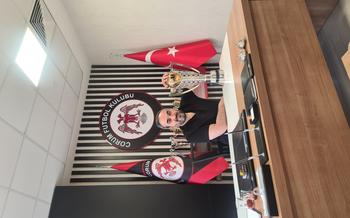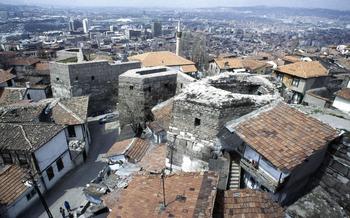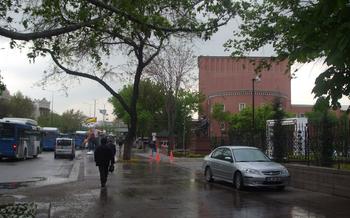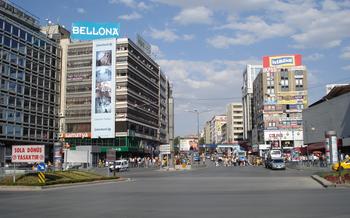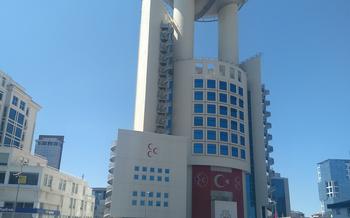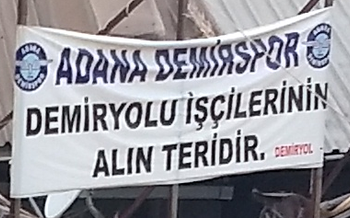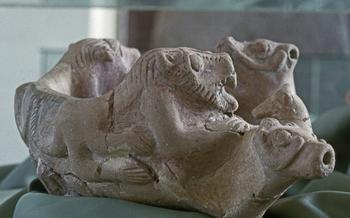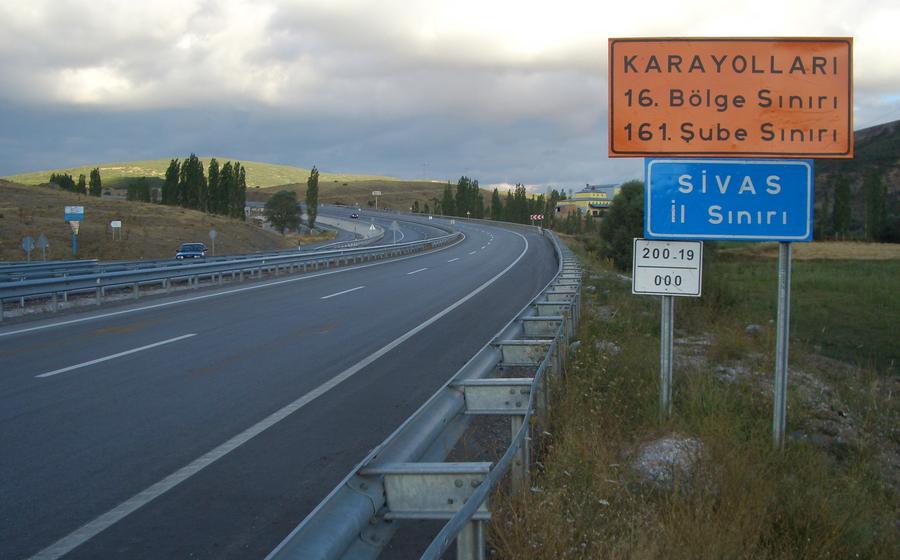
Yozgat Arkeoloji Müzesi (Yozgat Archaeology Museum)
- Yozgat Arkeoloji Müzesi: A Journey Through History
- Unveiling the Treasures: Artifacts and Exhibits
- Exploring the Museum's Layout and Design
- Delving into the Hittite Legacy
- Artifacts and Inscriptions
- Rock Reliefs
- Historical Context
- Discovering the Phrygian Heritage
- Encountering Roman Grandeur
- The Museum's Educational Programs
- Planning Your Visit: Essential Information
- Capturing the Museum's Essence Through Photography
- Uncovering Hidden Gems in Yozgat
- Respecting Museum Etiquette
- Engaging with the Museum's Staff
- Exploring the Museum's Online Resources
- Preserving the Museum's Legacy
- Insider Tip: Unforgettable Experiences
Yozgat Arkeoloji Müzesi: A Journey Through History
Nestled in the heart of Anatolia, the Yozgat Arkeoloji Müzesi (Yozgat Archaeology Museum) stands as a testament to the region's rich cultural heritage. Established in 1970, the museum houses a diverse collection of artifacts that narrate the captivating story of Yozgat's past, from the ancient Hittites to the Phrygians and Romans.
The museum's journey began with a modest collection of artifacts discovered during archaeological excavations in the Yozgat region. Over the years, the collection has grown significantly, thanks to ongoing excavations and generous donations from local communities. Today, the museum boasts a treasure trove of over 15,000 artifacts, each meticulously preserved and displayed to provide visitors with a glimpse into Yozgat's vibrant history.
The museum's collection is not merely a display of ancient objects; it is a testament to the ingenuity, artistry, and cultural diversity that have shaped this region for centuries. From intricate Hittite cuneiform tablets to exquisite Phrygian jewelry, from finely crafted Roman sculptures to delicate Byzantine mosaics, the artifacts at the Yozgat Archaeology Museum offer a tangible connection to the past, allowing visitors to embark on a journey through time and immerse themselves in the stories of civilizations long gone.
Unveiling the Treasures: Artifacts and Exhibits
The Yozgat Arkeoloji Müzesi houses a diverse collection of artifacts that narrate the captivating history of Yozgat and its surrounding regions. Embark on a journey through time as you explore ancient treasures from various civilizations that once flourished in this land.
-
Ancient Civilizations: Witness the grandeur of the Hittite, Phrygian, and Roman civilizations through their exquisite artifacts. Discover intricate cuneiform tablets, majestic sculptures, and finely crafted pottery that provide glimpses into their rich cultural heritage.
-
Pottery and Ceramics: Marvel at the artistry and craftsmanship of ancient potters and ceramicists. Admire the delicate designs, vibrant colors, and intricate patterns that adorn these vessels, each telling a unique story of daily life and artistic expression.
-
Sculptures and Statues: Encounter mesmerizing sculptures and statues that bring history to life. Gaze upon the stoic faces of Hittite rulers, admire the graceful forms of Phrygian deities, and witness the expressive gestures of Roman emperors, all frozen in time and stone.
-
Mosaics and Frescoes: Immerse yourself in the vibrant world of mosaics and frescoes that adorn the museum's walls and floors. Marvel at the intricate patterns, vivid colors, and captivating scenes that depict mythological tales, historical events, and everyday life in ancient Yozgat.
Exploring the Museum's Layout and Design
The Yozgat Arkeoloji Müzesi is meticulously organized into distinct galleries and sections, each dedicated to showcasing specific periods and themes. As you navigate the museum, you'll embark on a chronological journey through history, tracing the evolution of civilizations that once thrived in this region.
Thematic displays are thoughtfully curated to provide a comprehensive understanding of each era. Artifacts are arranged in a captivating manner, telling the stories of ancient cultures and their contributions to Anatolian history. Interactive elements, such as touchscreens and multimedia presentations, further enhance the museum experience, making it both educational and engaging for visitors of all ages.
Accessibility is a key priority at the Yozgat Arkeoloji Müzesi. The museum is wheelchair accessible, with ramps and elevators providing easy access to all levels. Braille signage and audio guides are available for visually impaired visitors, ensuring that everyone can fully immerse themselves in the museum's rich collection.
Delving into the Hittite Legacy
The Yozgat Arkeoloji Müzesi (Yozgat Archaeology Museum) houses a wealth of artifacts and exhibits that shed light on the rich history of the Hittite civilization, one of the most powerful ancient empires in Anatolia. The Hittites ruled over vast territories in central and eastern Anatolia from approximately 1600 to 1200 BCE, leaving behind an enduring legacy that continues to fascinate historians and archaeologists to this day.
Artifacts and Inscriptions
The museum's collection of Hittite artifacts includes cuneiform inscriptions, seals, and various tools and weapons. These objects provide valuable insights into the Hittites' language, writing system, and daily life. Visitors can admire the intricate carvings on Hittite seals, which often depict mythological scenes or royal figures. Cuneiform tablets, inscribed with records of Hittite laws, treaties, and historical events, offer a glimpse into the political and administrative systems of the empire.
Rock Reliefs
One of the highlights of the museum's Hittite collection is a series of impressive rock reliefs that depict Hittite rulers and deities. These reliefs, which were originally found in various locations throughout Yozgat province, have been carefully preserved and displayed in the museum. Visitors can marvel at the skill and artistry of the Hittite sculptors, who carved these reliefs into the natural rock formations. The reliefs provide a visual representation of Hittite religious beliefs and royal iconography.
Historical Context
The museum's exhibits also provide visitors with a comprehensive understanding of the historical context of the Hittite Empire. Visitors can learn about the rise and fall of the Hittite kingdom, their military prowess, and their cultural achievements. The museum also highlights the Hittites' interactions with other civilizations, such as the Egyptians and the Assyrians. By exploring the Hittite collection at the Yozgat Arkeoloji Müzesi, visitors gain a deeper appreciation for the significance of this ancient civilization and its lasting impact on the history of Anatolia.
Discovering the Phrygian Heritage
The Phrygians, an ancient Indo-European people, left an indelible mark on the history and culture of Anatolia. The Yozgat Arkeoloji Müzesi houses a significant collection of artifacts that provide a glimpse into their fascinating world.
Phrygian Culture: A Tapestry of Traditions
The Phrygians were known for their unique customs and traditions, which are vividly reflected in the museum's exhibits. Visitors can admire intricate jewelry crafted from gold and silver, showcasing the Phrygians' exceptional skills in metalworking. Woven textiles and vibrant ceramics further reveal their artistic talents and appreciation for beauty.
Phrygian Art and Crafts: A Legacy of Exquisite Craftsmanship
The Phrygians were renowned for their exquisite craftsmanship, particularly in the realm of metalworking. The museum showcases a stunning collection of Phrygian jewelry, including delicate earrings, intricate necklaces, and elaborate bracelets. These adornments often feature intricate designs and motifs, reflecting the Phrygians' rich cultural heritage.
Midas Tumulus: Unveiling the Secrets of a Legendary King
Among the museum's most captivating exhibits is the Midas Tumulus, a Phrygian royal tomb discovered in the nearby Gordion archaeological site. This magnificent structure, dating back to the 8th century BC, is believed to be the burial place of King Midas, a legendary figure known for his golden touch. The tumulus contains a wealth of artifacts, including gold jewelry, bronze vessels, and exquisite furniture, offering a glimpse into the opulence and power of the Phrygian monarchy.
Historical Significance: The Phrygians' Enduring Legacy
The Phrygians played a pivotal role in shaping the history of Anatolia. They established a powerful kingdom that spanned much of central and western Turkey, and their influence extended far beyond their borders. The museum's exhibits provide a deeper understanding of the Phrygians' political, economic, and cultural contributions, highlighting their enduring legacy in the region.
Encountering Roman Grandeur
The Yozgat Arkeoloji Müzesi houses a remarkable collection of artifacts that shed light on the Roman period in Anatolia. Visitors can examine a diverse range of Roman coins, each bearing the effigies of emperors and depicting significant historical events. Exquisite pottery and ceramic pieces showcase the artistic prowess of Roman craftsmen, adorned with intricate designs and vibrant colors. Architectural fragments, including columns, capitals, and inscriptions, provide glimpses into the grandeur of Roman structures that once graced the region.
These artifacts collectively narrate the story of Yozgat's transformation into a thriving trading hub during the Roman era. The city's strategic location along trade routes facilitated the exchange of goods and ideas between the Roman Empire and its neighboring regions. Visitors to the museum can trace the routes of these ancient trade networks and explore the impact of Roman commerce on the development of Yozgat and the surrounding area.
Unveiling the Roman legacy in Yozgat through the museum's collection offers a profound understanding of the empire's enduring influence on the region. From coins and pottery to architectural elements, each artifact serves as a testament to the Romans' profound impact on Anatolian history and culture.
The Museum's Educational Programs
The Yozgat Archaeology Museum is not merely a repository of ancient artifacts; it is also a hub of education and cultural enrichment. The museum offers a diverse range of educational programs that cater to visitors of all ages and backgrounds.
Workshops and Lectures: The museum frequently organizes educational workshops and lectures conducted by experts in archaeology, history, and related fields. These programs provide in-depth insights into specific topics related to the museum's collection and the region's history.
School Programs: The museum recognizes the importance of engaging young minds with history and culture. It offers interactive programs tailored to school groups, designed to make learning about the past fun and engaging. These programs include guided tours, hands-on activities, and educational games.
Research Opportunities: For those with a passion for research, the Yozgat Archaeology Museum provides opportunities for collaboration and exploration. Scholars and researchers can access the museum's collection and resources to conduct their own studies and contribute to the field of archaeology.
Community Outreach: The museum extends its educational reach beyond its walls through community outreach initiatives. It participates in local events, collaborates with educational institutions, and organizes outreach programs to promote cultural heritage and foster a sense of community pride.
Planning Your Visit: Essential Information
Location and Accessibility:
The Yozgat Arkeoloji Müzesi is conveniently located in the heart of Yozgat, on [Address]. Whether you're arriving by car or public transportation, the museum is easily accessible. For those driving, ample parking is available nearby. If you prefer to take public transportation, there are several bus routes that stop within walking distance of the museum.
Hours of Operation:
The museum is open to the public [Days of the week and hours of operation], ensuring ample opportunities to plan your visit. However, it is advisable to check the museum's website or social media pages for any special holiday schedules or temporary closures.
Admission Fees:
Admission to the Yozgat Arkeoloji Müzesi is [Admission fee]. Concessions and discounts are available for students, seniors, and groups. Be sure to inquire about these discounts when purchasing your tickets.
Guided Tours:
Guided tours of the museum are available upon request. These tours provide a deeper insight into the museum's collection and history, and are led by knowledgeable and experienced museum staff. Guided tours can be arranged by contacting the museum in advance.
Capturing the Museum's Essence Through Photography
Photography enthusiasts will delight in capturing the essence of Yozgat Arkeoloji Müzesi through their lenses. While photography is generally permitted within the museum, it is essential to familiarize yourself with the museum's photography policy to ensure you adhere to preservation guidelines and respect the integrity of the artifacts.
To capture stunning photographs of artifacts, consider composition and lighting techniques. Experiment with different angles and perspectives to create compelling images that showcase the beauty and uniqueness of each piece. Remember to use natural light whenever possible, as flash photography is often prohibited to protect artifacts from damage.
Share your museum photography experience with the world by utilizing social media platforms. Tag the museum and use relevant hashtags to connect with other photography enthusiasts and share your unique perspective on the museum's collection.
Uncovering Hidden Gems in Yozgat
Your journey to Yozgat doesn't end with the museum. The city and its surroundings offer a wealth of hidden gems waiting to be uncovered. Indulge in the flavors of traditional Yozgat cuisine, where culinary delights await your palate. Explore ancient ruins and monuments that whisper tales of bygone eras. Discover the breathtaking natural beauty of Yozgat, with its captivating landscapes and serene parks. Immerse yourself in local festivals, traditional performances, and cultural events that showcase the vibrant spirit of the region. Yozgat is a treasure trove of experiences, inviting you to delve deeper and create memories that will last a lifetime.
Respecting Museum Etiquette
Adhering to proper museum etiquette is essential for preserving the integrity of the museum's collection and ensuring a positive experience for all visitors. Visitors are expected to maintain respectful behavior within the museum's premises, including refraining from touching or handling artifacts. The museum's collection is invaluable, and it is crucial to respect the preservation guidelines in place to protect these artifacts for future generations.
Museum visitors should also be mindful of their noise levels to create a peaceful environment for everyone. Loud talking or disruptive behavior can be distracting to other visitors and detract from the overall museum experience. Flash photography is generally not permitted within museums, as it can damage light-sensitive artifacts and disturb other visitors. By following these guidelines, visitors can contribute to a respectful and enjoyable atmosphere within the Yozgat Arkeoloji Müzesi.
Engaging with the Museum's Staff
The knowledgeable and friendly staff at the Yozgat Arkeoloji Müzesi are invaluable resources for enhancing your museum experience. Don't hesitate to approach them with any questions, requests for assistance, or recommendations. They can provide insights into the museum's collection, history, and ongoing projects.
If you're interested in a guided tour, the museum staff can arrange one for you, ensuring you get the most out of your visit. Guided tours offer a deeper understanding of the museum's artifacts and the stories they tell.
The museum staff is also receptive to feedback and suggestions from visitors. Share your thoughts and ideas with them, as they are always looking for ways to improve the museum and provide the best possible experience for visitors.
By engaging with the museum staff, you'll not only gain a deeper appreciation for the museum and its collection but also establish connections with individuals who are passionate about preserving and sharing the region's cultural heritage.
Exploring the Museum's Online Resources
In the digital age, the Yozgat Arkeoloji Müzesi (Yozgat Archaeology Museum) extends its reach beyond its physical walls through a wealth of online resources. Embark on virtual tours to explore the museum's galleries and exhibits from the comfort of your own home. Dive into the museum's online collection database to discover artifacts and learn about their significance. The museum's website also offers a range of educational resources, including articles, videos, and interactive content that delve deeper into the history and culture of the region. Engage with the museum on social media platforms to stay updated on the latest exhibitions, events, and announcements, and share your own museum experiences with the community.
Preserving the Museum's Legacy
The Yozgat Arkeoloji Müzesi is dedicated to preserving the cultural heritage of the region through various conservation efforts. The museum's dedicated staff works tirelessly to protect and restore artifacts, ensuring their longevity for future generations. Visitors can contribute to these efforts by handling artifacts with care, refraining from touching or moving them, and adhering to the museum's photography guidelines.
Supporting the museum through donations or volunteer work is another meaningful way to contribute to its preservation. Donations can help fund conservation projects, educational programs, and the acquisition of new artifacts. Volunteers can assist with tasks such as artifact documentation, museum tours, and community outreach events.
Advocating for the preservation of cultural heritage is crucial for ensuring the museum's continued success. Visitors can raise awareness about the museum's significance by sharing their experiences on social media, writing positive reviews, and encouraging others to visit. Additionally, they can support organizations dedicated to protecting cultural heritage and advocating for policies that promote its preservation.
The Yozgat Arkeoloji Müzesi is committed to sustainable practices and environmental responsibility. The museum utilizes energy-efficient lighting, recycling programs, and eco-friendly cleaning products to minimize its ecological impact. Visitors can contribute to these efforts by being mindful of their energy and water consumption during their visit.
By engaging in these preservation efforts, visitors can play a vital role in ensuring the Yozgat Arkeoloji Müzesi's legacy continues to inspire and educate generations to come.
Insider Tip: Unforgettable Experiences
Beyond the main attractions, the Yozgat Arkeoloji Müzesi holds hidden treasures that offer unique insights into the region's rich history. Explore lesser-known artifacts or exhibits that may not be immediately noticeable but hold captivating stories.
To fully immerse yourself in the museum's ambiance, consider visiting during the off-season. The quieter atmosphere allows for a more intimate and crowd-free experience, enabling you toじっくりと explore the exhibits and connect with the museum's collection on a deeper level.
Hiring local guides can also enhance your visit. These knowledgeable individuals provide personalized insights and anecdotes about the museum and Yozgat's history, bringing the past to life and creating a memorable experience.
For photography enthusiasts, participating in photography workshops organized by the museum is a fantastic opportunity to hone your skills and capture stunning images of the artifacts and exhibits. Learn from experienced photographers and discover the art of museum photography, ensuring you leave with a lasting visual record of your visit.


